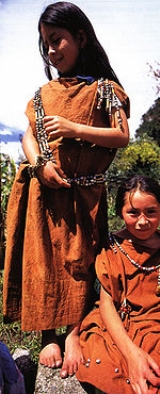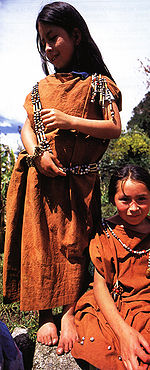
Yanesha' people
Encyclopedia

Ethnic group
An ethnic group is a group of people whose members identify with each other, through a common heritage, often consisting of a common language, a common culture and/or an ideology that stresses common ancestry or endogamy...
of the Peruvian Amazon rainforest. Presently, the most recent census count
Census
A census is the procedure of systematically acquiring and recording information about the members of a given population. It is a regularly occurring and official count of a particular population. The term is used mostly in connection with national population and housing censuses; other common...
puts their population
Population
A population is all the organisms that both belong to the same group or species and live in the same geographical area. The area that is used to define a sexual population is such that inter-breeding is possible between any pair within the area and more probable than cross-breeding with individuals...
at over 7,000 distributed among 48 communities located in Puerto Inca Province
Puerto Inca Province
The Puerto Inca Province is the largest of eleven provinces of the Huánuco Region in Peru. The capital of this province is the city of Puerto Inca.-Boundaries:*North: Ucayali Region*East: Ucayali Region*South: Pasco Region...
(Huánuco
Huánuco Region
Huánuco is a region in central Peru. It is bordered by the La Libertad, San Martín, Loreto and Ucayali regions on the north; the Ucayali Region on the east; the Pasco Region on the south; and the Lima and Ancash regions on the west. Its capital is the city of Huánuco.Huánuco has a rough topography...
), Chanchamayo Province
Chanchamayo Province
Chanchamayo is a province in northern Junín Region, in central Peru.The province's name derives from the Chanchamayo River, whose source is in the Andean Sierra and flows northwards becoming the Perené River....
(Junín
Junín Region
Junín is a region in the central highlands and westernmost Amazonia of Peru. Its capital is Huancayo.-Geography:The region has a very heterogeneous topography. The western cordillera located near the border with the Lima Region, has snowy and ice covered peaks. On the east, there are high glacier...
) and Oxapampa Province
Oxapampa Province
The Oxapampa Province is the largest of three provinces that make up the Pasco Region in Peru. The capital of the Oxapampa province is the city of Oxapampa.-Political division:...
(Pasco
Pasco Region
Pasco is a region in central Peru. Its capital is Cerro de Pasco.-Political division:The region is divided into 3 provinces , which are composed of 28 districts .-Provinces:...
). They are a relatively small group making up barely 2.91% of indigenous
Indigenous peoples in Peru
Indigenous people in Peru comprise a large number of distinct ethnic groups who inhabited the country's present territory prior to its discovery by Europeans around 1500...
inhabitants located in the Peruvian Amazon. Their communities are situated in altitudes ranging from 200 to 1600 meters above sea level
Sea level
Mean sea level is a measure of the average height of the ocean's surface ; used as a standard in reckoning land elevation...
and can also be found along the shores of various river
River
A river is a natural watercourse, usually freshwater, flowing towards an ocean, a lake, a sea, or another river. In a few cases, a river simply flows into the ground or dries up completely before reaching another body of water. Small rivers may also be called by several other names, including...
s including the Pichis, Palcazu
Palcazu River
The Palcazu River is a river in Peru which forms from the confluence of the Bocaz and Cacazú rivers, who are born in the mountains of the mountain range of San Carlos....
, Pachitea, Huancabamba
Huancabamba river
The Huancabamba River has its origin in the confluence of the rivers Huaylamayo and Chontabamba in Peru. The upper course is formed by the basins of these rivers. The middle course is between Huancabamba and the Pozuzo and its lower course between Pozuzo and the confluence with the river Palcazú....
, Cacazú, Chorobamba, and the Yurinaqui.
History
The Amuesha, calling themselves Yanesha', speak Yanesha'Yanesha' language
Yanesha , also called Amuesha or Amoesha is a language spoken by the Amuesha people of Peru in central and eastern Pasco Region.Due to the influence and domination of the Inca Empire, Yanesha' has many loanwords from Quechua, including some core vocabulary...
, a language belonging to the Maipurean
Maipurean
Arawakan , also known as Maipurean , is a language family that spans from the Caribbean and Central America to every country in South America except Ecuador, Uruguay and Chile...
language family
Language family
A language family is a group of languages related through descent from a common ancestor, called the proto-language of that family. The term 'family' comes from the tree model of language origination in historical linguistics, which makes use of a metaphor comparing languages to people in a...
that also includes Asháninka
Asháninka language
Asháninka is an Arawakan language spoken by the Asháninca people along the Apurímac, Ene, Perené, and Tambo Rivers and tributaries in Perú. Their ethnic group numbers from 25,000 to 30,000. Many of them still speak their native tongue....
, the Yine, etc. Their first contact with the Western World
Western world
The Western world, also known as the West and the Occident , is a term referring to the countries of Western Europe , the countries of the Americas, as well all countries of Northern and Central Europe, Australia and New Zealand...
came through friar
Friar
A friar is a member of one of the mendicant orders.-Friars and monks:...
s who, in the second half of the 16th century, made an incursion into the region. However, it wasn’t until the 18th century that missionaries (this time Franciscan
Franciscan
Most Franciscans are members of Roman Catholic religious orders founded by Saint Francis of Assisi. Besides Roman Catholic communities, there are also Old Catholic, Anglican, Lutheran, ecumenical and Non-denominational Franciscan communities....
s) managed to establish steady relations with the Yanesha’ and other ethnic groups living nearby. The Father Francisco de San José founded various missions around Cerro de la Sal and Quimiri in order to convert the indigenous populations to Christianity
Christianity
Christianity is a monotheistic religion based on the life and teachings of Jesus as presented in canonical gospels and other New Testament writings...
. However, in 1742, indigenous people commanded by Juan Santos Atahualpa
Juan Santos Atahualpa
Juan Santos Atahualpa was a leader of an indigenous rebellion in the Andean jungle provinces of Tarma and Jauja, near what was then Spanish Peru in the mid 18th century....
rebelled against the Spaniards and destroyed a number of missions, effectively cutting off outside contact for several decades.
It’s not known for sure the population of the Yanesha' people at this time but they had certainly already begun to die off from European diseases. During the 19th century, the area inhabited by the Yanesha’ and other groups was reexplored by expeditions looking to establish routes to the lower Amazon and to colonize the area.
The arrival of western people represented for the Yanesha' the loss of land and a dramatic change of living customs ensued; they were grouped into towns and their extensive territories became the property of colonists. With this situation, they were compelled to group together and became the first ethnic group to form a professional organization: the Amuesha Congress. This later became the Yanesha' Federation. The Law of Indigenous Communities (sp
Spanish language
Spanish , also known as Castilian , is a Romance language in the Ibero-Romance group that evolved from several languages and dialects in central-northern Iberia around the 9th century and gradually spread with the expansion of the Kingdom of Castile into central and southern Iberia during the...
: La Ley de Comunidades Indígenas), promulgated in 1974, partly repaired the situation of dispossession by granting some land to Yanesha' groups.
The Yanesha' people once lived through hunting
Hunting
Hunting is the practice of pursuing any living thing, usually wildlife, for food, recreation, or trade. In present-day use, the term refers to lawful hunting, as distinguished from poaching, which is the killing, trapping or capture of the hunted species contrary to applicable law...
, fishing
Fishing
Fishing is the activity of trying to catch wild fish. Fish are normally caught in the wild. Techniques for catching fish include hand gathering, spearing, netting, angling and trapping....
, and subsistence agriculture
Subsistence agriculture
Subsistence agriculture is self-sufficiency farming in which the farmers focus on growing enough food to feed their families. The typical subsistence farm has a range of crops and animals needed by the family to eat and clothe themselves during the year. Planting decisions are made with an eye...
; in modern times, the emphasis is on agricultural diversification
Agricultural diversification
In the agricultural context, diversification can be regarded as the re-allocation of some of a farm's productive resources, such as land, capital, farm equipment and paid labour, into new activities...
and cultivation of cash crop
Cash crop
In agriculture, a cash crop is a crop which is grown for profit.The term is used to differentiate from subsistence crops, which are those fed to the producer's own livestock or grown as food for the producer's family...
s like coffee
Coffee
Coffee is a brewed beverage with a dark,init brooo acidic flavor prepared from the roasted seeds of the coffee plant, colloquially called coffee beans. The beans are found in coffee cherries, which grow on trees cultivated in over 70 countries, primarily in equatorial Latin America, Southeast Asia,...
and annatto
Annatto
Annatto, sometimes called roucou or achiote, is a derivative of the achiote trees of tropical regions of the Americas, used to produce a yellow to orange food coloring and also as a flavoring...
. Hunting became much rarer after the Yanesha' people began raising animals for consumption. In addition, groups have begun exploiting Cat’s claw
Uncaria tomentosa
Uncaria tomentosa is a woody vine found in the tropical jungles of South and Central America, which derives its name from its claw-shaped thorns...
. The marketing of ceramic craft
Craft
A craft is a branch of a profession that requires some particular kind of skilled work. In historical sense, particularly as pertinent to the Medieval history and earlier, the term is usually applied towards people occupied in small-scale production of goods.-Development from the past until...
s has also become a source of income.
In 1988, a territory of over 34,774 hectare
Hectare
The hectare is a metric unit of area defined as 10,000 square metres , and primarily used in the measurement of land. In 1795, when the metric system was introduced, the are was defined as being 100 square metres and the hectare was thus 100 ares or 1/100 km2...
s was set up in Palcazu District
Palcazu District
Palcazu District is one of seven districts of the province Oxapampa in Peru.-References:...
as the Yanesha' Communal Reservation
Yanesha Communal Reservation
The Communal Reservation Yanesha lodges a wild fauna that serves them as sustenance, emphasizing the red deer, to the majaz, to the sajino, and fish as the zúngaro and the boquichico....
(Reserva Communal Yanesha) with the purpose of protecting important fauna
Fauna
Fauna or faunæ is all of the animal life of any particular region or time. The corresponding term for plants is flora.Zoologists and paleontologists use fauna to refer to a typical collection of animals found in a specific time or place, e.g. the "Sonoran Desert fauna" or the "Burgess shale fauna"...
that serves as sustenance to Yanesha' communities in the area.

